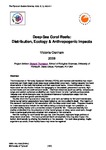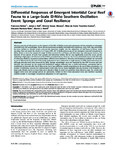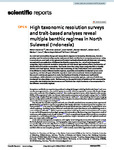Deep-Sea Coral Reefs: Distribution, Ecology and Anthropogenic Impacts
| dc.contributor.author | Oakham, V. | |
| dc.date.accessioned | 2019-05-13T10:46:30Z | |
| dc.date.available | 2019-05-13T10:46:30Z | |
| dc.date.issued | 2009 | |
| dc.identifier.citation |
Oakham, V. (2009) 'Deep-Sea Coral Reefs: Distribution, Ecology & Anthropogenic Impacts', The Plymouth Student Scientist, p. 203-211. | en_US |
| dc.identifier.issn | 1754-2383 | |
| dc.identifier.uri | http://hdl.handle.net/10026.1/13863 | |
| dc.description.abstract |
The introduction of Remotely Operated Vehicles (ROVs) and manned submersibles has meant scientists can finally begin study deep-water scleractinian coral reefs, making valuable first-hand observations of the reefs themselves and their associated fauna. Known influences of deepwater coral reef distribution include the topography of the seabed, presence of currents, high nutrient levels and low sedimentation levels. Chemical tolerances (such as salinity, temperature range and calcium carbonate availability) are mostly known for only Lophelia pertusa corals. Debates exist within literature over the possible influence of hydrocarbon seeps from the seabed on coral reef growth and distribution. Studies show the importance of deep-water coral reefs as habitat for fish and invertebrates. Some faunal habitat associations have been looked at, yet not studied in detail. The majority of this research has looked for fish association with the deep-water coral reefs. Proposed reasons for these associations include the reef habitat being a structural refuge from predation, a suitable feeding habitat and a protective nursery for juvenile fish. There are relatively few studies undertaken into the presence of other faunal groups on deep-water coral reefs, though there is some qualitative data obtained from analyses of fish stomachs. Benthic trawling for commercial fish spp has, over the years, destroyed large portions of deep-water coral reefs. The future predicted rise in atmospheric CO2 may also impact this habitat detrimentally by altering the chemistry of the seawater. For such slow-growing, fragile organisms as corals, these habitat loses may never be regained. | en_US |
| dc.language.iso | en | en_US |
| dc.publisher | University of Plymouth | |
| dc.rights | Attribution 3.0 United States | * |
| dc.rights.uri | http://creativecommons.org/licenses/by/3.0/us/ | * |
| dc.subject | Deep-Sea Coral Reefs | en_US |
| dc.subject | reef | en_US |
| dc.subject | coral | en_US |
| dc.subject | corals | en_US |
| dc.subject | Remotely Operated Vehicles | en_US |
| dc.subject | Chemical tolerances | en_US |
| dc.subject | fish | en_US |
| dc.subject | invertebrates | en_US |
| dc.subject | marine | en_US |
| dc.subject | ecology | en_US |
| dc.subject | scleractinian coral reefs | en_US |
| dc.subject | Lophelia pertusa | en_US |
| dc.title | Deep-Sea Coral Reefs: Distribution, Ecology and Anthropogenic Impacts | en_US |
| dc.type | Article | |
| plymouth.issue | 1 | |
| plymouth.volume | 2 | |
| plymouth.journal | The Plymouth Student Scientist |





